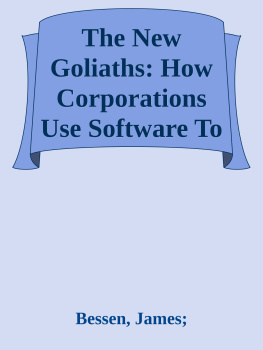Bessen James - The New Goliaths: How Corporations Use Software To Dominate Industries, Kill Innovation, And Undermine Regulation
Here you can read online Bessen James - The New Goliaths: How Corporations Use Software To Dominate Industries, Kill Innovation, And Undermine Regulation full text of the book (entire story) in english for free. Download pdf and epub, get meaning, cover and reviews about this ebook. genre: Business. Description of the work, (preface) as well as reviews are available. Best literature library LitArk.com created for fans of good reading and offers a wide selection of genres:
Romance novel
Science fiction
Adventure
Detective
Science
History
Home and family
Prose
Art
Politics
Computer
Non-fiction
Religion
Business
Children
Humor
Choose a favorite category and find really read worthwhile books. Enjoy immersion in the world of imagination, feel the emotions of the characters or learn something new for yourself, make an fascinating discovery.
- Book:The New Goliaths: How Corporations Use Software To Dominate Industries, Kill Innovation, And Undermine Regulation
- Author:
- Genre:
- Rating:3 / 5
- Favourites:Add to favourites
- Your mark:
- 60
- 1
- 2
- 3
- 4
- 5
The New Goliaths: How Corporations Use Software To Dominate Industries, Kill Innovation, And Undermine Regulation: summary, description and annotation
We offer to read an annotation, description, summary or preface (depends on what the author of the book "The New Goliaths: How Corporations Use Software To Dominate Industries, Kill Innovation, And Undermine Regulation" wrote himself). If you haven't found the necessary information about the book — write in the comments, we will try to find it.
Bessen James: author's other books
Who wrote The New Goliaths: How Corporations Use Software To Dominate Industries, Kill Innovation, And Undermine Regulation? Find out the surname, the name of the author of the book and a list of all author's works by series.
The New Goliaths: How Corporations Use Software To Dominate Industries, Kill Innovation, And Undermine Regulation — read online for free the complete book (whole text) full work
Below is the text of the book, divided by pages. System saving the place of the last page read, allows you to conveniently read the book "The New Goliaths: How Corporations Use Software To Dominate Industries, Kill Innovation, And Undermine Regulation" online for free, without having to search again every time where you left off. Put a bookmark, and you can go to the page where you finished reading at any time.
Font size:
Interval:
Bookmark:
 The New Goliaths This page intentionally left blank
The New Goliaths This page intentionally left blank The New Goliaths How Corporations Use Software to Dominate Industries, Kill Innovation, and Undermine Regulation James Bessen New Haven & London Published with assistance from the foundation established in memory of Philip Hamilton McMillan of the Class of 1894, Yale College. Copyright 2022 by James Bessen. All rights reserved. This book may not be reproduced, in whole or in part, including illustrations, in any form (beyond that copying permitted by Sections 107 and 108 of the U.S. Copyright Law and except by reviewers for the public press), without written permission from the publishers. Yale University Press books may be purchased in quantity for educa tional, business, or promotional use.
The New Goliaths How Corporations Use Software to Dominate Industries, Kill Innovation, and Undermine Regulation James Bessen New Haven & London Published with assistance from the foundation established in memory of Philip Hamilton McMillan of the Class of 1894, Yale College. Copyright 2022 by James Bessen. All rights reserved. This book may not be reproduced, in whole or in part, including illustrations, in any form (beyond that copying permitted by Sections 107 and 108 of the U.S. Copyright Law and except by reviewers for the public press), without written permission from the publishers. Yale University Press books may be purchased in quantity for educa tional, business, or promotional use.
For information, please e-mail Set in Galliard type by IDS Infotech Ltd., Chandigarh, India. Printed in the United States of America. Library of Congress Control Number: 2021946319 ISBN 978-0-300-25504-1 (hardcover : alk. paper) A catalogue record for this book is available from the British Library. This paper meets the requirements of ANSI/NISO Z39.48-1992 (Permanence of Paper). Fast Company, one of the magazines created to herald this change, declared in August 2001 that this democratic capitalist move ment was about the expansion of individual opportunity, the disruptive energy of ceaseless innovation, and the transformative power of informa tion technology and communications. Fast Company, one of the magazines created to herald this change, declared in August 2001 that this democratic capitalist move ment was about the expansion of individual opportunity, the disruptive energy of ceaseless innovation, and the transformative power of informa tion technology and communications.
Individuals could access inexpen sive new computer and networking technology, learn valuable skills, innovate, create new companies based on their innovations, grow these companies rapidly by focusing on their core competencies, outsource other tasks to global partners thanks to the communications-enabled death of distance, and ultimately disrupt entrenched old economy companies. Many people were skeptical, none more so than leading economists. While recognizing that new information technology helped deliver strong productivity growth (growth in output per worker) in the 1990s, Martin Feldstein, who had been chairman of the Council of Economic Advisers under Ronald Reagan, asserted that it did not fundamentally transform the relationships that govern economic processes in the United States. Alan Greenspan, chairman of the Federal Reserve, agreed, arguing that new technology was just continuing its role in Schumpeterian creative destruction, replacing older technologies with newer, more productive ones. Indeed, if anything, he saw information technology accelerating the process of creative destruction that had been under way at least since the Industrial Revolution. ix x PREFACE But neither the New Economy vision nor the views of the economist critics has aged well.
Information technology (IT) is indeed fundamentally transforming economic processes, although not along the lines of the New Economy. Not only did that vision fail, but the actual effect of information technology has been the opposite of what was predicted in many areas. And rather than accelerating creative destruction, information technology is suppressing it today. Information technology is changing the nature of markets, innovation, and firm organization, exacerbating economic divi sions, and undermining government regulation. It is, in fact, changing the basic nature of capitalism. The origins of this book date back thirty years to when I was running a software company.
During the 1980s and 1990s, low-cost computers did indeed level the playing field, allowing individuals and small firms to access powerful technology. For instance, bar code scanning allowed small retail stores to use advanced merchandising and inventory control tools. New companies sprung up, taking advantage of new opportunities, sometimes growing to disrupt entrenched, old technology firms. I ran one of those new companies, a startup that developed one of the first desktop publishing programs. My experience made me aware of a nascent trend. Our customers used our technology to customize print publications in order to target individuals or small demographic groups.
For instance, the grocery chain A&P used our publishing software to pro duce different weekly ad circulars targeting the dozens of store shopping zones within each metropolitan area. Software gave them the flexibility to use the individual and demographic data they were now collecting on a large scale. I wrote about this trend in 1993 in an article in the HarvardBusiness Review titled Riding the Marketing Information Wave. When I left business and became an academic researcher, I wanted to explore this trend further, but at the time there was little evidence to sug gest that it led to far-reaching change in the economy. That changed. Walmart took that same basic bar code scanner technology and used it to build a massive logistics and inventory management system connecting stores, suppliers, and warehouses with the enormous flow of data from its scanners.
This system, deployed with a new business model and orga nizational structure, allowed Walmart to offer greater selection in stores, to respond more rapidly to changing demand, and to do this with less PREFACE xi inventory and lower transportation costs. Using this advantage, Walmart grew to dominate the retail sector. Other companies in other sectors also built large IT systems and used them to achieve industry dominance. Automobile companies and aircraft manufacturers built multi-billion dollar systems to design new cars and jets, which themselves now depend heavily on software; banks developed systems to use financial data to target consumers with tailored credit card offers while managing risk; Google and Facebook developed systems to use data from online activity to target consumers with advertising. These systems involved a major shift of invest ment into proprietary software and the persistent dominance of leading firms within their industries. What these disparate systems have in common is that they allow firms to better address highly heterogeneous and sometimes rapidly changing demands of their customers.
They do this by adding features or selection that increase the complexity of their offerings. Compared to its rivals, Walmart efficiently manages far greater selection in its stores and does so more efficiently; leading automobiles and jets have far more features; leading banks and advertisers do far more detailed targeting. When people think about the economic impact of computers, they often focus on prices, the rapidly falling prices of computer hardware, or the low cost of repro ducing software. Here another, less remarked characteristic of software is also at play: compared to tangible systems, it is relatively inexpensive to add a feature to a software system; hence, complexity can be managed cost-effectively at a much larger scale. Firms compete on complexity. Although this technology helped firms succeed, until I started thinking about historical context, I still did not see that it fundamentally changed economic processes.
New technologies do not typically change basic eco nomic and social relations, but beginning in the late nineteenth century, they did. Firms in many industries began to achieve major gains in efficiency by producing at large scale. The building blocks of industry, steel and electricity, became much more affordable. New types of large firms emerged and came to dominate their industries, changing competition, labor mar kets, economic integration, and innovation processes. And with great economic power came opportunities for abuse and political corruption. The Progressive Era response was to counterbalance growing corporate power with new regulatory power of the state over competition, food and xii PREFACE medicine safety, employment abuses, child labor, political corruption, and more.
Next pageFont size:
Interval:
Bookmark:
Similar books «The New Goliaths: How Corporations Use Software To Dominate Industries, Kill Innovation, And Undermine Regulation»
Look at similar books to The New Goliaths: How Corporations Use Software To Dominate Industries, Kill Innovation, And Undermine Regulation. We have selected literature similar in name and meaning in the hope of providing readers with more options to find new, interesting, not yet read works.
Discussion, reviews of the book The New Goliaths: How Corporations Use Software To Dominate Industries, Kill Innovation, And Undermine Regulation and just readers' own opinions. Leave your comments, write what you think about the work, its meaning or the main characters. Specify what exactly you liked and what you didn't like, and why you think so.








